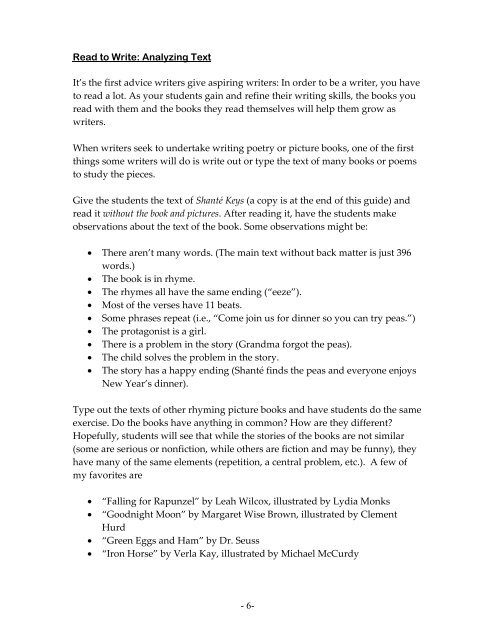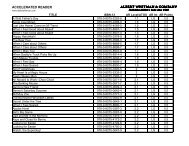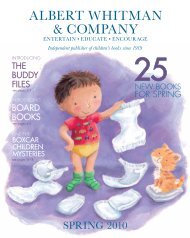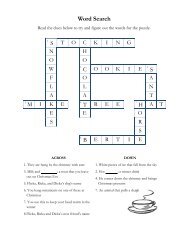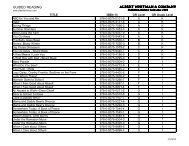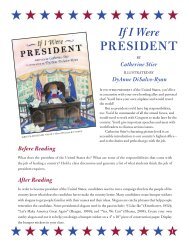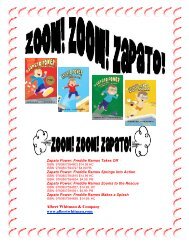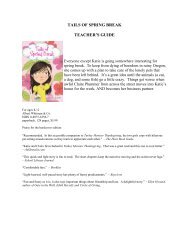Shanté Keys and the New Year's Peas Activity - Albert Whitman ...
Shanté Keys and the New Year's Peas Activity - Albert Whitman ...
Shanté Keys and the New Year's Peas Activity - Albert Whitman ...
Create successful ePaper yourself
Turn your PDF publications into a flip-book with our unique Google optimized e-Paper software.
Read to Write: Analyzing Text<br />
It’s <strong>the</strong> first advice writers give aspiring writers: In order to be a writer, you have<br />
to read a lot. As your students gain <strong>and</strong> refine <strong>the</strong>ir writing skills, <strong>the</strong> books you<br />
read with <strong>the</strong>m <strong>and</strong> <strong>the</strong> books <strong>the</strong>y read <strong>the</strong>mselves will help <strong>the</strong>m grow as<br />
writers.<br />
When writers seek to undertake writing poetry or picture books, one of <strong>the</strong> first<br />
things some writers will do is write out or type <strong>the</strong> text of many books or poems<br />
to study <strong>the</strong> pieces.<br />
Give <strong>the</strong> students <strong>the</strong> text of <strong>Shanté</strong> <strong>Keys</strong> (a copy is at <strong>the</strong> end of this guide) <strong>and</strong><br />
read it without <strong>the</strong> book <strong>and</strong> pictures. After reading it, have <strong>the</strong> students make<br />
observations about <strong>the</strong> text of <strong>the</strong> book. Some observations might be:<br />
There aren’t many words. (The main text without back matter is just 396<br />
words.)<br />
The book is in rhyme.<br />
The rhymes all have <strong>the</strong> same ending (“eeze”).<br />
Most of <strong>the</strong> verses have 11 beats.<br />
Some phrases repeat (i.e., “Come join us for dinner so you can try peas.”)<br />
The protagonist is a girl.<br />
There is a problem in <strong>the</strong> story (Gr<strong>and</strong>ma forgot <strong>the</strong> peas).<br />
The child solves <strong>the</strong> problem in <strong>the</strong> story.<br />
The story has a happy ending (<strong>Shanté</strong> finds <strong>the</strong> peas <strong>and</strong> everyone enjoys<br />
<strong>New</strong> Year’s dinner).<br />
Type out <strong>the</strong> texts of o<strong>the</strong>r rhyming picture books <strong>and</strong> have students do <strong>the</strong> same<br />
exercise. Do <strong>the</strong> books have anything in common? How are <strong>the</strong>y different?<br />
Hopefully, students will see that while <strong>the</strong> stories of <strong>the</strong> books are not similar<br />
(some are serious or nonfiction, while o<strong>the</strong>rs are fiction <strong>and</strong> may be funny), <strong>the</strong>y<br />
have many of <strong>the</strong> same elements (repetition, a central problem, etc.). A few of<br />
my favorites are<br />
“Falling for Rapunzel” by Leah Wilcox, illustrated by Lydia Monks<br />
“Goodnight Moon” by Margaret Wise Brown, illustrated by Clement<br />
Hurd<br />
“Green Eggs <strong>and</strong> Ham” by Dr. Seuss<br />
“Iron Horse” by Verla Kay, illustrated by Michael McCurdy<br />
- 6-


